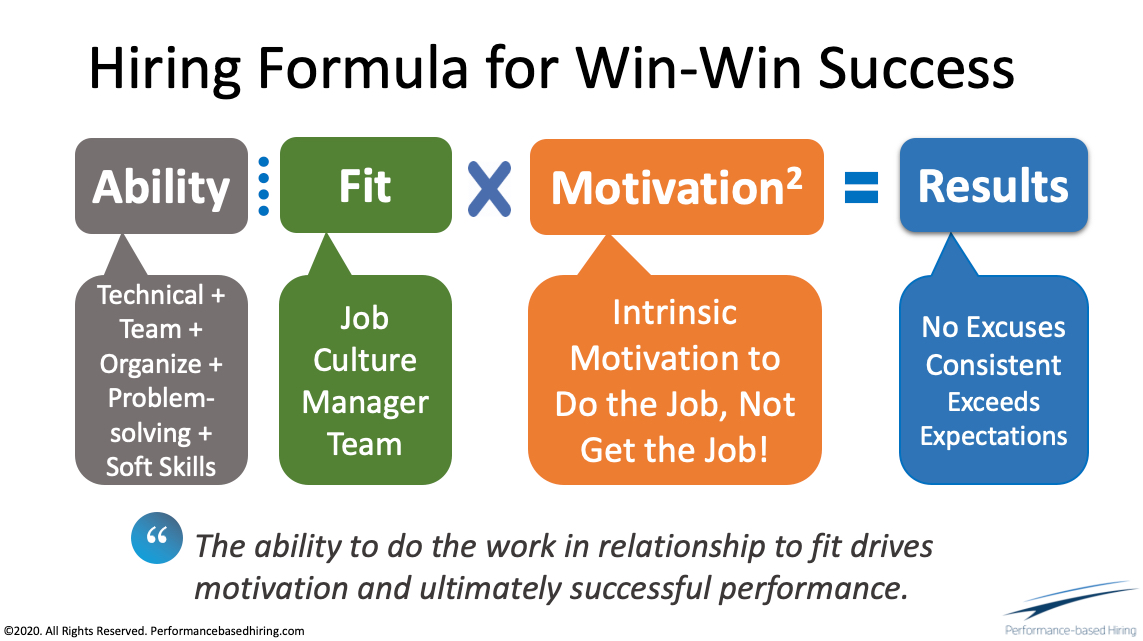The ability to do the work in relationship to fit drives motivation and ultimately successful performance.
Over the past 40+ years I’ve conducted more than five thousand interviews and developed a theory about interviewing that seems to work 85% of the time. I call it the “Whole-Brain” Performance-based Interview.
The semi-scientific explanation starts by recognizing that the brain consists of four core parts:
- The left brain is more analytical and process focused. (I’ve been told this is not true, but in this story it’s a metaphor. If this explanation bothers you, you’re a left-brainer, metaphorically speaking.)
- The right brain is more creative and intuitive. (If you think this makes a lot of sense, you’re a right-brainer in this metaphor.)
- The emotional brain – limbic system – is how we make dumb decisions in seconds judging people on whether we like them or not. This is also referred to as the “friend vs. foe” response or “stupid switch.”
- The decision-maker (prefrontal cortex) takes inputs from these other three regions and makes some type of hiring decision.

Unfortunately — at least for interviewing accuracy purposes — the logical decision-maker is typically overridden by the emotional brain’s “stupid switch” when a candidate arrives in person for an interview. When the response is negative, the interviewer asks hardball questions in a vain attempt to escape the uncomfortable situation. When the initial response is positive, the interviewer asks softball questions, leans forward, and goes into sales mode. About 50% of all hiring errors are due to this subconscious reaction – hiring people we shouldn’t have and not hiring those we should. The other 50% of mistakes is attributed to not assessing soft skills properly since it’s clear that people are largely hired for their technical skills yet when they underperform it’s most often due to their lack of soft skills.
Interviewers are not all influenced to the same degree by this emotional response. Techies are the least affected, and if you look closely, you’ll see their left brains are a bit bigger than most people. As a result, they tend to be conservative, less willing to make a decision without lots of proof, and value experience and the depth of technical skills over potential. While most of their hires are technically strong due to this type of decision-making, it’s less likely these people will have the soft skills necessary to become all-around strong performers since they’re only superficially assessed.
Those who emphasize right-brain decision-making, typically managers and executives, place more trust in their intuition over facts and evidence overvaluing first impressions, strong communication skills, intelligence, and assertiveness. As a consequence, they typically hire people who are smart and strategic but their subsequent performance swings widely when considering team building and achieving consistent results.
Then there are others who ignore their brains entirely and just go with their gut reaction. Salespeople tend to fall into this category more than other functions. In this case their hiring results are across the board, with wide and violent swings in either direction. This is typically why sales jobs have higher turnover than most positions.
The “Whole-Brain” Performance-based Interview process corrects all of these problems. Here’s a quick overview:
- Think Win-Win Hiring. When the measure of success is hiring for the anniversary date, rather than the start, managers tend to conduct multiple and more in-depth interviews to ensure fit, performance and potential.
- Define success, not skills. By converting generic skills and competencies into performance objectives you change how candidates are interviewed by digging deeply into their comparable accomplishments.
- Phone screen everyone. By asking candidates to describe some of their major accomplishments related to real job needs before meeting them onsite, you not only save time but also minimize the impact of first impression bias.
- Trust Sherlock Holmes more than yourself. Getting evidence of past performance doing comparable work is a “left brain” deductive interviewing approach that replaces emotions, intuition and bias with facts, details and logic.
- Solve a problem together. Describe a problem the person is likely to face on the job and ask what information they’d need to figure it out and how long it would take. Assess the quality of the questions, not the answer to the problem, to assess “right brain” thinking and problem-solving ability.
- Use the Hiring Formula for Success to predict performance. As shown in the graphic, the ability to do the work in relationship to fit is what drives motivation and successful performance. Our Quality of Hire Talent Scorecard will help organize the evidence needed to complete the formula.
Somehow the human brain doesn’t work properly when making hiring decisions. The “Whole-Brain” Performance-based Interview was designed to sort through this hodgepodge of emotions, biases, and semi-facts in some logical way to generate a reasonably accurate decision. Based on my own experience it works 85% of the time.


